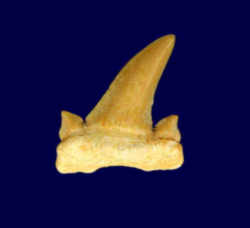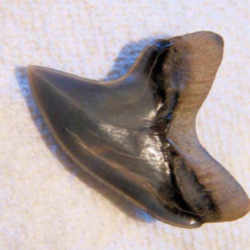
Georgia Symbols
Georgia State Fossil
Cretaceous - Miocene, Shark Tooth

(undetermined)
Adopted in 1976.
Georgia's official state fossil is the Cretaceous - Miocene, Shark Tooth. The Cretaceous - Miocene, Shark Tooth was adopted in 1976. Sharks have skeletons composed of cartilage rather than bone, so usually the only fossilized remains they leave are their teeth. These teeth are produced and continually shed in a conveyor-belt fashion, and an individual shark may produce 10,000 teeth during its lifetime. Many types of sharks lived in prehistoric Georgia, ranging from small Cretaceous forms to large, fierce Miocene species. Sharks as a group appeared during the Ordovician, but the earliest teeth found in Georgia date from the Late Cretaceous, about 65 million years ago
Georgia State Fossil:
Cretaceous - Miocene, Shark Tooth

Probably one of the most sought-after fossils by amateur collectors, the shark tooth is a relatively common fossil in the Georgia coastal plain. In fossil form, the shark tooth can be traced back 375,000,000 years. Fossilized shark teeth are found in a range of colors--from the more common blacks and grays to whites, browns, blues and reddish browns.
Description
A shark tooth is one of the numerous teeth of a shark. Sharks continually shed their teeth, and some Carcharhiniformes shed approximately 35,000 teeth in a lifetime. In some geological formations, shark's teeth are a common fossil. These fossils can be analyzed for information on shark evolution and biology, especially because the teeth are often the only part of the shark to be fossilized, in fact fossil teeth comprise much of the fossil record of the Elasmobranchii, extending back hundreds of millions of years.
Since shark skeletons are composed of cartilage rather than bone, shark teeth are often the only part of a shark to fossilize and survive hundreds of millions of years. Sharks continually shed their teeth, up to tens of thousands in a lifetime, making shark tooth fossils plentiful. Approximately 2,000 species of fossil shark have been described.Fossils mainly date from the Miocene epoch through the late Cretaceous period, making them approximately 8 to 150 million years old. Fossilized shark teeth of up to 450 million years of age have been found. Most commonly black or shades of gray, fossil shark teeth can also be white, brown, and even shades of red and blue. The minerals present in the sediment surrounding the tooth determine its color.
Act of Georgia General Assembly March 18, 1976
OFFICIAL STATE MINERAL, FOSSIL, AND QUARTZ DESIGNATED.
No. 104 (House Resolution No. 517-1385).
The resolution, shown below offers explanation for the adoption of each of these symbols to represent the State of Georgia.
A Resolution.
Designating staurolite as the official State mineral, the shark tooth as the official State fossil and quartz as the official State gem; and for other
purposes.
Whereas, Georgia has a wealth of minerals and gemstones; and
Whereas, staurolite is a mineral found in old crystalline rocks and is particularly well known and abundant in north Georgia; and
Whereas, staurolite crystals are known mostly as "Fairy Crosses"or "Fairy Stones", and generations after generations have collected
them for good luck charms; and
Whereas, the shark tooth is a relatively common fossil in Georgia and in fossil form can be traced back 375,000,000 years; and
Whereas, the teeth are especially prized for fossil collectors and range in color from the more common blacks and grays to white, brown, blue and reddish
brown; and
Whereas, quartz is the second most abundant mineral on Earth, and Georgia is blessed with a great deal of it in a wide variety of colors; and
Whereas, quartz is the amethyst that has been most used in jewelry, and clear quartz when faceted resembles diamond; and
Whereas, the importance of Georgia's minerals to the industrial growth and heritage of this State should be appropriately recognized.
Now, therefore, be it resolved by the General Assembly of Georgia that the following designations are hereby made:
(1) Staurolite is designated as the State of Georgia's official mineral.
(2) The shark tooth is designated as the State of Georgia's official fossil.
(3) Quartz is designated as the State of Georgia's official gem.
Approved May 18, 1976.
Source: Ga. Laws 1976, pp. 567-68.
Georgia Law
The law designating the shark tooth as the official Georgia state fossil is found in the Georgia Code, Title 50, Chapter 3, Section 50-3-56.
TITLE 50. STATE GOVERNMENT
CHAPTER 3. STATE FLAG, SEAL, AND OTHER SYMBOLS
ARTICLE 3. OTHER STATE SYMBOLS
O.C.G.A. §50-3-56 (2014)
§ 50-3-56. Official fossil
The shark tooth is designated as the official Georgia state fossil.
HISTORY: Ga. L. 1976, p. 567.

Some states that lack a "state fossil" have nevertheless singled out a fossil for formal designation such as a state dinosaur, rock, gem or stone.






